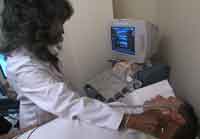NASA space technology is helping doctors diagnose and monitor treatments for hardening of the arteries in its early stages, before it causes heart attacks and strokes.
Hospitals and doctors around the US are using ArterioVision software initially developed at NASA's Jet Propulsion Laboratory, Pasadena, CA, along with a standardised, painless, non-invasive ultrasound examination of the carotid artery, which carries blood from the heart to the brain.
A standard carotid ultrasound measures plaque and blood flow within the artery. When an ultrasound is used with the software, the test measures the thickness of the inner two layers of the carotid artery - the intima and media. Medical Technologies International (MTI) of Palm Desert, CA patented the ArterioVision software.
Arterial thickening provides the earliest evidence of atherosclerosis, or hardening of the arteries, the beginning stage of a disease process that leads to heart disease and stroke. Doctors can use this carotid intima media thickness (CIMT) measurement to calculate the age of the patient's arteries, which does not always match the patient's calendar age.

Read-outs from carotid artery tests reveal a patient's vascular age.
‘Once patients see how thick their arteries are, there is much more incentive for them to change their lifestyle with dietary modification and exercise. Physicians also can use the test to monitor and change current medications,’ said Dr. Howard N. Hodis of the Keck School of Medicine at the University of Southern California, Los Angeles.
The US Food and Drug Administration has approved the new diagnostic tool, called the ArterioVision CIMT procedure. Robert Selzer, MTI chief engineer, worked in JPL's Image Processing Laboratory for 15 years, where the technology was developed that ultimately led to the software used in ArterioVision.
‘This is such a precise method of examining the carotid artery. It can distinguish between 256 shades of grey at a subpixel level,’ Selzer said. ‘You need that kind of detail to help catch heart disease as early as you can, often before there are any outward symptoms.’
During the test, a patient lies on an examination table while a technician applies gel to the neck to image the carotid arteries, located on both sides of the neck near the skin's surface. The technician uses an ultrasound machine while following a patented protocol to capture specific images of the carotid artery wall. Using the ArterioVision software, the physician generates a CIMT measurement and a report that identifies the patient's risk profile when compared to people of the same gender and age.
JPL's Image Processing Laboratory was created in 1966 to receive and make sense of spacecraft imagery. In the lab, the NASA-invented Video Imaging Communication and Retrieval software has been used to process pictures from numerous space missions, including the Voyagers and Mars Reconnaissance Orbiter. Periodic upgrades of the imaging software have enabled greater accuracy and improved knowledge of our solar system, and have laid the groundwork for understanding images of all kinds.
The ArterioVision test was developed with JPL's Innovative Partnerships Program, designed to bring benefits of the space program to the public.




Red Bull makes hydrogen fuel cell play with AVL
Formula 1 is an anachronistic anomaly where its only cutting edge is in engine development. The rules prohibit any real innovation and there would be...